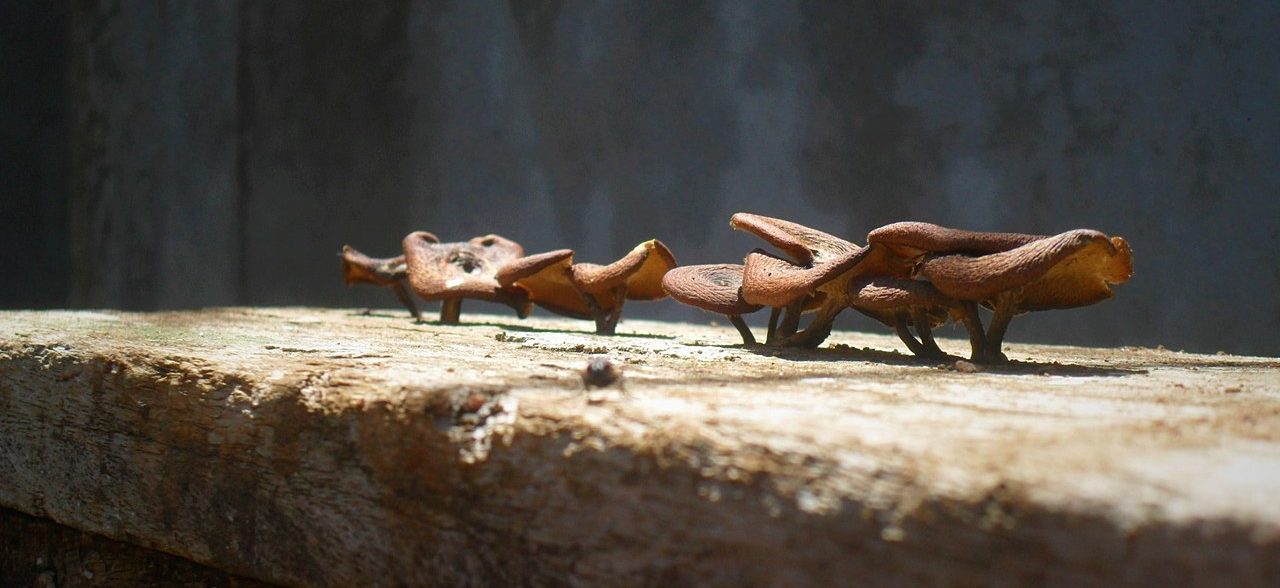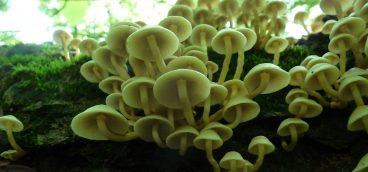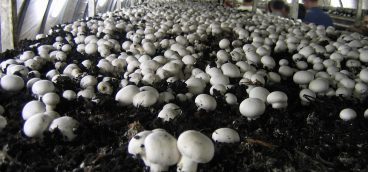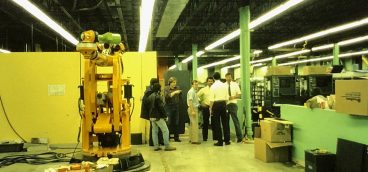Meddling with Mushrooms

“A meal without mushrooms is like a day without rain.” — John Cage
Previously in this series: Basking in the Mushroom Limelight
“I learned more about psychology in the five hours after taking these mushrooms than in the preceding 15 years of studying and doing research.” — Timothy Leary
It’s almost impossible to exaggerate what an extraordinary place the Butler County Mushroom Farm was. I’ve mentioned the large pile of manure on the BCMF property – what I thought of as Mt. Horsesh*t. But this wasn’t any ordinary manure, and it wasn’t even any ordinary horse manure.
Mr. Y knew that the quality of any crop depended directly on the quality of the soil it was grown in, and therefore he wanted only the best. Hence, BCMF entered into long-term, take-or-pay contracts with several thoroughbred horse farms around Lexington, Kentucky. The thoroughbred horse manure would be gathered up, loaded into rail cars, and transported by (smelly) train to West Winfield, Pennsylvania.
When I first learned about mushroom farming, I’d wondered how it worked. Did you plant mushroom seeds in the spring and then harvest mushrooms in the fall? The answer to that question is: no. Mushrooms are very ancient plants, having developed millions of years before flowering plants. While the latter produce seeds, mushrooms produce spores, which spread from delicate gills under the mushroom’s cap.
The manure brought up from Lexington was offloaded onto Mt. Horsesh*t and became the feedstock for the best compost in the world. The finished compost was transported into the limestone mines, a thin layer of topsoil was added, along with mushroom spores (known in commercial mushroom farming as “spawn”), and bingo! In a few weeks you got three crops of mushrooms. Sometimes the mushrooms doubled in size in a day.
The limestone mines were extraordinary. Three hundred feet underground, they featured 40 miles of roads. The mines maintained a constant temperature of about 60 degrees and a constant humidity of 95 percent – ideal growing conditions for mushrooms. Note that mushrooms don’t need sunlight because there is no photosynthesis going on.
Inside these vast mines BCMF could produce 60 tons of mushrooms per year, far more than any other grower before or since.
But back to OSHA. A hearing on the merits of our petition was coming up and I was struggling to think of any merits. Basically, we were just furious that a huge, ignorant bureaucracy was jerking a little company around for no sensible reason. But that argument wasn’t likely to get far with a federal judge.
Fortunately, I was bailed out by OSHA itself. The muckety-mucks at the top of OSHA, who reported to the US Secretary of Labor, were terrified that a judge might issue a decision that would then serve as a precedent for other companies that were being jerked around.
OSHA proposed a compromise. Instead of buying 950 pairs of steel-toed work shoes, BCMF would offer to buy them for any employee who wanted them. BCMF agreed and made the offer – 14 employees took them up on it. None of them ever wore the shoes to work (they were way too uncomfortable), those employees just thought it would be nice to own a pair of steel-toed work shoes.
BCMF had bested OSHA, but then the Pennsylvania Department of Environmental Resources (DER) got in on the act – it’s now known as the Department of Environmental Protection. And like OSHA, they applied coal-mining rules to a mushroom-farming company.
Coal mines are dangerous places. Ceilings and walls can collapse, fires can break out, explosions can happen. It’s therefore extremely important to know who’s still down in the mine and who got out. So OSHA requires every coal mine to have a strict log showing every miner who goes down in the mine and every miner who comes out.
A former limestone mine being used for mushroom farming is not a dangerous place. Once active mining ceased, the limestone “caves” were extraordinarily stable. Since BCMF began operations in 1937 there had been no ceiling or wall collapses, no fires, no explosions. A thousand years from now the same thing could be said.
But try to tell that to the DER. They insisted that BCMF install a coalmine-like log-in system. Not only was this unnecessary as a safety feature, but BCMF already had such a system in place. The mushroom pickers were hourly employees who went down in the mine, punched in on the time clock, and punched out when they left. BCMF knew exactly who was down there and who wasn’t.
But this wasn’t acceptable to the DER – they wanted BCMF to install a duplicate system of logging in. It wasn’t terribly expensive, but, as Mr. Y said, “It’s a matter of principle. If we let them get away with this, pretty soon they’ll be telling me what side of the bed I can sleep on!”
We fought the DER all the way to the Pennsylvania Supreme Court, winning some and losing some. After the Pennsylvania Commonwealth Court agreed with us that a duplicate system wasn’t necessary, the DER gave up on that. However, they pointed out that supervisory employees were salaried and didn’t punch a time clock. They wanted BCMF to install a log-in system for those employees and the Supreme Court agreed with them.
But that wasn’t the end of the matter. The supervisors hated having to log in and out. They went down in the mines many times a day and it was a big pain to stop, climb out of their vehicles, and sign in, then do the same on the way out. So they adopted a slightly different practice.
The first time the supervisors went down in the mine during their shifts they would log in, and the first time they came back out they would log out. The rest of the time they didn’t bother. When the DER inspectors came around, the log looked fine, so they thought everything was copacetic.
I knew nothing about this shortcut and that was a good thing – lawyers are “officers of the court” and I would have had to stop the practice. But one evening over dinner Mr. Y gleefully told me about it. Faced with a knotty ethical dilemma, I gave Mr. Y my best tough-lawyer stare and said, “This conversation never happened.”
Next up: The Life and Death of Moonlight Mushrooms, Part 4











